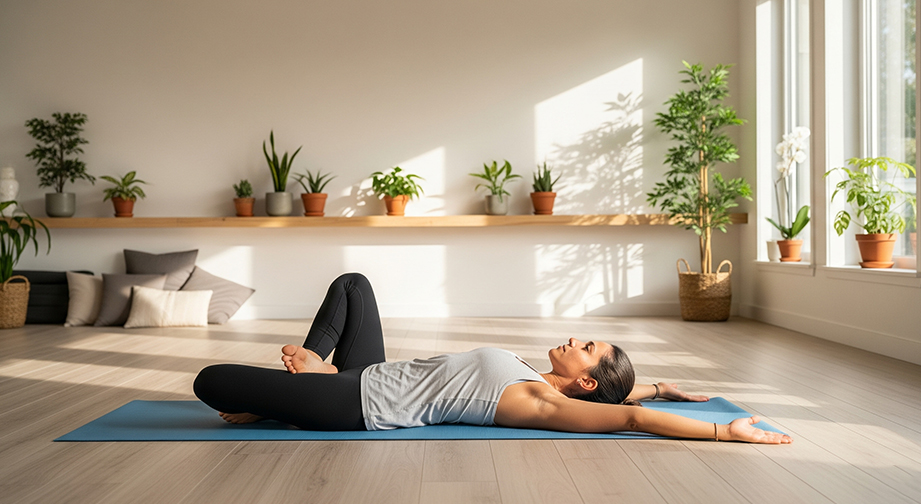Jathara Parivartanasana (Belly Twist): The Reclining Yoga Pose Your Spine Will Love
Introduction
Jathara Parivartanasana—don’t let the long Sanskrit name throw you! Pronounced ja-tha-rah pari-vart-ana-asana, this posture is simply the Belly Twist Pose, a gentle reclining position that helps release tension and bring a calming sense of balance to your practice.
The Sanskrit literally means “Stomach (“Jathara”) Rotating (“Parivartana”) Pose (“Asana”).” At its core, Jathara Parivartanasana is about unlocking tightness, aiding digestion, and soothing the body and mind. Its essence? Calm, gentle detoxification.
If you’ve ever felt stiff after a long day at your desk or wanted instant relief from a sore lower back, Jathara Parivartanasana might just become your new best friend.
Step-by-Step Guide to Jathara Parivartanasana (Belly Twist Pose)

- Lie down comfortably on your back, legs extended, arms resting by your sides. Take a few deep breaths to settle in.
- Bend your knees and place your feet flat on the mat, hip-width apart.
- Extend your arms out to the sides in a “T” shape, palms facing up or down (whichever feels more stable).
- On an exhale, gently let your knees fall to the right, stacking them, while keeping both shoulders rooted to the mat.
- Turn your head to the left, for a gentle twist through the neck and spine (optional).
- Breathe slowly: Inhale deeply into your belly, expanding the ribs. As you exhale, allow your legs to relax closer to the mat.
- Hold for 5–10 steady breaths (about 30–60 seconds), feeling the gentle massage through the belly and lower back.
- Inhale, draw knees back to center. Exhale and repeat the twist to the left side.
- Complete 2–3 rounds on each side, or as feels comfortable in your sequence.
- Beginners: Place a bolster or cushion under your knees for gentle support.
- Advanced: Straighten one leg out, or draw knees closer to the armpit for a deep twist.
Alignment & Safety Tips
- Keep both shoulders anchored to the mat—avoid letting one lift up!
- Let the knees stack (not perfectly aligned is okay—just relaxed).
- Move within pain-free limits—mild stretching is fine, sharp pain is not.
- Avoid forced twisting, especially if you have back, hip, or abdominal injuries.
- Pregnant yogis: Practice only under a teacher’s guidance.
Common mistakes: Forcing knees to the floor, straining neck, or letting the upper back arch—keep it gentle & supported.
Benefits of Jathara Parivartanasana
Physical Benefits
- Gently stretches the lower back & spine
- Opens chest and shoulders
- Stimulates the digestive organs and helps with bloating or sluggishness
- Relieves stiffness from sitting or traveling
- Improves flexibility in the hips and spine
Mental Benefits
- Releases stress and calms the nervous system
- Promotes deep relaxation and better sleep
- Encourages mindfulness and present-moment awareness
Energy / Chakra Connection
- Stimulates the Manipura (Solar Plexus) Chakra—encouraging confidence, metabolism, and inner power
- Balances right/left energy (sun/moon) in the body
Contraindications
- Recent or chronic injury to spine, hips, or abdomen
- Disc issues or severe sciatica
- Pregnancy (unless modified & approved by a teacher)
- Hernia or recent abdominal surgery
Safer alternatives: Supine hugging knees to chest, gentle supported supine twists with a bolster.
Beginner’s Tips & Variations
- Props: Place a yoga block or cushion under both knees to reduce the intensity.
- Wall support: Place your feet on the wall to control the depth of the twist.
- Bolster or rolled blanket under knees prevents over-twisting.
- Gentle variation: Keep feet flat, knees only a few inches toward the side.
- Advanced version: Extend the top leg straight, hold the foot with the opposite hand.
How to Include in a Yoga Flow
- Best as: A cool-down or closing pose to soothe the spine and nervous system.
- Pairs well with:
- Apanasana (Knees-to-Chest Pose)
- Supta Matsyendrasana (Reclining Spinal Twist)
- Setu Bandhasana (Bridge Pose) before or after for balanced spine work
Mind-Body Connection
As you practice Jathara Parivartanasana, direct your breath into the side waist and lower belly. Notice tension melting with each exhale, and let the twist symbolize letting go—on both a physical and emotional level. This posture gently activates the solar plexus chakra, associated with digestion, energy, and self-confidence.
Summary Box
- Asana Name: Belly Twist / Reclining Twist Pose (Jathara Parivartanasana)
- Level: Beginner
- Focus Areas: Spine, core, lower back, hips
- Duration: 30–60 seconds per side (& repeat 2–3 times)
- Best Time to Practice: Morning to gently awaken or evening to unwind
Frequently Asked Questions (FAQs)
- Is Jathara Parivartanasana safe for beginners?
- Yes! This pose is gentle and accessible—just go slowly and use props for support if needed.
- Can Jathara Parivartanasana relieve back pain?
- It often helps release tension, but always check with your doctor if you're dealing with chronic back pain or injuries.
- Should my knees touch the ground in this position?
- No need! Let knees rest wherever is comfortable. Over time, your flexibility will naturally improve.
Remember, Jathara Parivartanasana is about gentle release and restoration—no force, no rush. Breathe deeply, move mindfully, and let the twist do its magic!